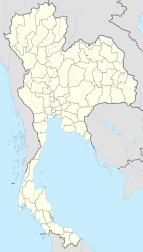Nan, Thailand
|
Nan น่าน |
|
|---|---|
| Town | |

The city pillar of Nan at Wat Ming Mueang
|
|
| Coordinates: 18°47′N 100°47′E / 18.783°N 100.783°ECoordinates: 18°47′N 100°47′E / 18.783°N 100.783°E | |
| Country | Thailand |
| Province | Nan |
| Population (2010) | |
| • Total | 21,333 |
| Time zone | ICT (UTC+7) |
Nan (Thai: น่าน, pronounced [nâːn]) is a town in northern Thailand. It is 668 km north of Bangkok. It is in the centre of Nan Province which bears its name, and of which it is the former administrative capital. It covers the whole tambon Nai Wiang and parts of tambon Pha Sing of Mueang Nan district, an area of 7.60 km². In 2010 it had a population of 21,333. It is subdivided into 30 chumchon. It is spread along the Nan River's right bank. Nan is a small city, primarily devoted to commercial, administrative, educational, and hospital activities. The old heart of the city, where Wat Phumin, the national museum and other tourist attractions are located, is being restored. The city's industrial and tourist development remains limited until now, but should be improved by the complete opening of the border towards Laos and beyond towards China.
Little-known Nan goes back to the depths of the history of Thailand. For centuries it was a separate, autonomous kingdom with few relationships with the outside world.
There is much evidence of prehistoric habitation, but it wasn't until several small mueang united to form Nanthaburi on the Nan River in the mid-14th century, contemporaneously with the creation of Luang Prabang and the Lan Xang (Million Elephants) kingdom in Laos, that the city became a power to be taken into account. Associated with the mighty Sukhothai kingdom, the mueang took the title Wara Nakhon and played a significant part in the development of early Thai nationalism.
...
Wikipedia

